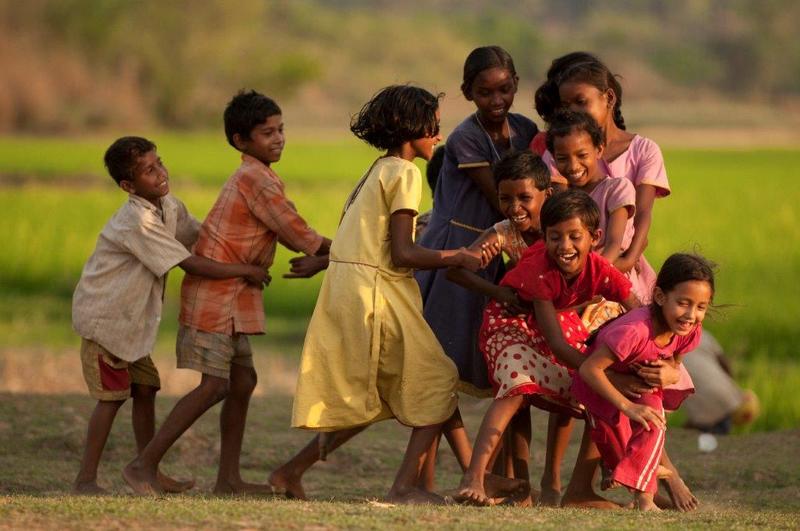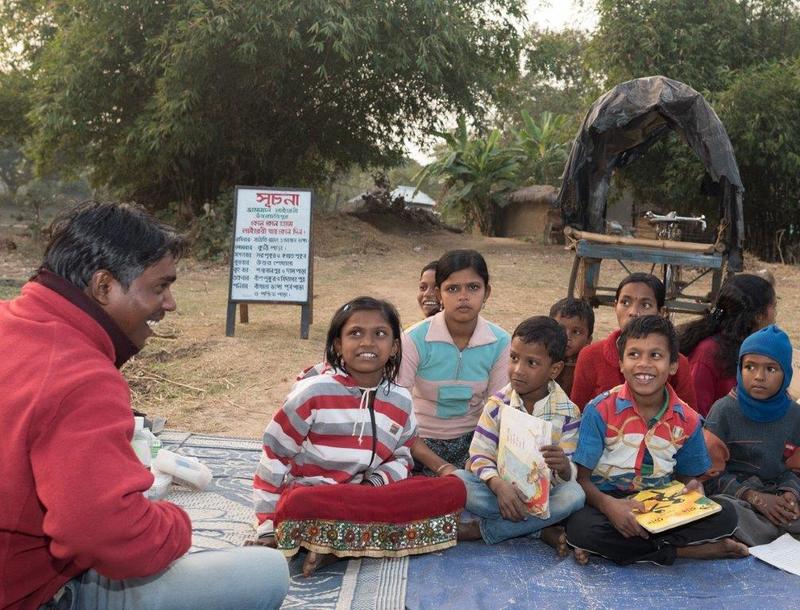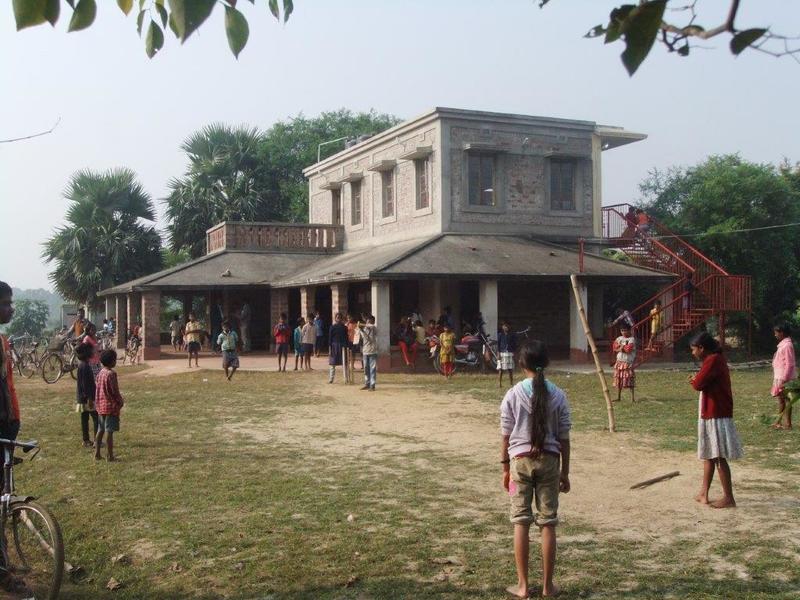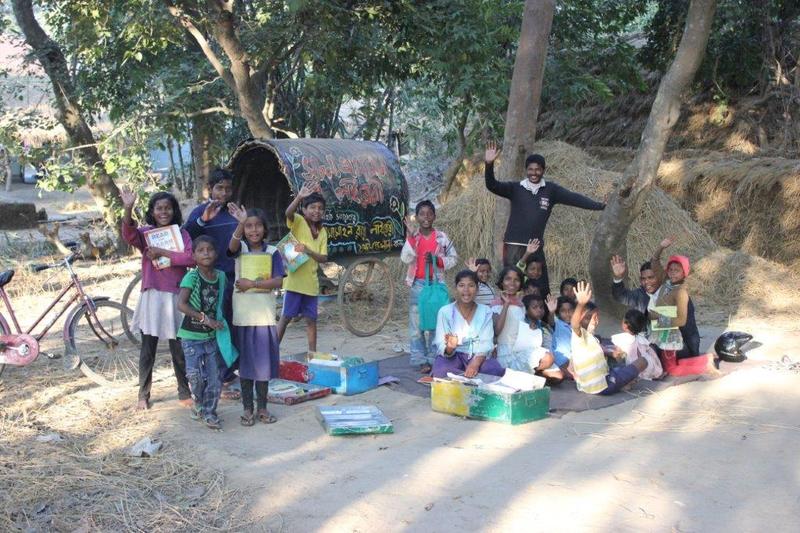ಕನ್ನಡವು ಕನ್ನಡವ ಕನ್ನಡಿಸುತಿರಲಿ: ರಾಜ್ಯೋತ್ಸವದ ಓದು ನಿಮ್ಮ ಮಗುವಿಗಾಗಿ!
Posted by Remya Padmadas on November 01, 2019Written by Hema, Editor- Kannada, Pratham Books
Who says math formulas are boring? Do you know how to recite a math concept through a wonderful story? Do you remember some funny things when your first teeth fell off? Have you ever witnessed a sunshower song? Who is Ahilyabai Holkar? On Kannada Rajyotsava, here are some amazing stories for you and your children. Read on to know more…
ಆಡಾಡಿಕೊಂಡು ಕಲಿ, ಕೇಳು ಕೇಳುತ್ತಲೇ ತಿಳಿ
1. Pishi and me - ನಾನು, ನನ್ನತ್ತೆ (Level 2)
https://storyweaver.org.in/stories/44731-naanu-nannatte
ಆಹ್, ಅತ್ತೆ ಎಷ್ಟು ಚೆಂದ. ನಾನು ಚಿಕ್ಕವಳಿದ್ದಾಗ ನನ್ನ ಚಿಕ್ಕತ್ತೆ ಹೈಸ್ಕೂಲಿನಲ್ಲಿ ಓದುತ್ತಿದ್ದರು. ನನ್ನ ಬಾಲ್ಯದ ನೆನಪುಗಳಲ್ಲಿ ನನಗೆ ತುಂಬಾ ನೆನೆಪಿರುವ ಸಂಗತಿಗಳು ಎಂದರೆ ಅತ್ತೆಯ ಜೊತೆ ಊರಿನ ಬೀದಿಗಳಲ್ಲಿ ತಿರುಗಿದ್ದು ಮತ್ತು ಬೇರೆ ಬೇರೆ ಜನರನ್ನು ಭೇಟಿಯಾಗಿದ್ದು.

ನಾನು, ನನ್ನತ್ತೆ ಕತೆಯ ಒಂದು ಚಿತ್ರ
ನನ್ನ ಸ್ನಾತಕೋತ್ತರ ಪದವಿ ಮುಗಿಯುತ್ತಿದ್ದಂತೆ ನಾನು ಅತ್ತೆಯಾದೆ ಅಂದರೆ ಅಣ್ಣನಿಗೆ ಮಗುವಾಯಿತು. ನನಗೇ ಇನ್ನೂ ಅತ್ತೆಯ ಜೊತೆಗಿನ ನೆನಪುಗಳು ನಿನ್ನೆ ಮೊನ್ನೆ ಎನ್ನುವ ಹಾಗಿದ್ದಾಗ ನಾನು ಅತ್ತೆಯಾಗಿದ್ದೆ. ಎಷ್ಚು ಚೆಂದದ ಭಾವ. ಅಣ್ಣನ ಮಗಳು ನನ್ನ ಜೊತೆ ಬರುವಾಗಲೆಲ್ಲ, ನಾನು ಅತ್ತೆಯ ಜೊತೆ ಹೋಗುವಾಗ ಮಾಡುತ್ತಿದ್ದ ಕೀಟಲೆಗಳನ್ನೇ ಮಾಡುತ್ತಿದ್ದಳು. ಇಡೀ ಕಥೆ ಮೂರು ತಲೆಮಾರುಗಳನ್ನು ಪ್ರತಿನಿಧಿಸುತ್ತದೆ ಎನ್ನುವುದೇ ನನಗೆ ಸೋಜಿಗ ಮೂಡಿಸುತ್ತದೆ. ಅದಕ್ಕಾಗಿ ನಾವು ಮೂವರೂ ‘ನಾನು, ನನ್ನತ್ತೆ’ ಕಥೆಯನ್ನು ಪದೇ ಪದೇ ಓದುತ್ತೇವೆ.
2. The Very Wiggly Tooth - ನಿಲ್ಲದ, ಬೀಳದ ಈ ಹಲ್ಲು! (Level 2)
https://storyweaver.org.in/stories/27656-nillada-beelada-ee-hallu
ಮನುಷ್ಯನಿಗೆ ಎರಡು ಹಂತದಲ್ಲಿ ಹಲ್ಲುಗಳು ಬರುತ್ತವೆ. ಮೊದಲನೆಯದು, ಎಳೆ ಹಲ್ಲು (ಹಾಲು ಹಲ್ಲು ಅಂತಾರೆ). ಇದು ಮಗುವಿನಲ್ಲಿ ಶುರುವಾಗಿ ಏಳೆಂಟು ವರ್ಷಗಳ ಹೊತ್ತಿಗೆ ಬಿದ್ದು ಹೋಗುತ್ತವೆ. ಹೀಗೆ ಬಿದ್ದ ಹಲ್ಲಿನ ಜಾಗದಲ್ಲಿ ಮೂಡುವ ಹಲ್ಲುಗಳನ್ನು ಶಾಶ್ವತ ಹಲ್ಲುಗಳೆನ್ನುತ್ತಾರೆ ಎನ್ನುತ್ತದೆ ವಿಜ್ಞಾನ.
ಮಕ್ಕಳಿಗೆ ಮೊದಲು ಮೂಡುವುದು ಮುಂದಿನ ಮೇಲಿನ ಅಥವಾ ಕೆಳಗಿನ ಎರಡು ಹಲ್ಲುಗಳು. ಆ ಹಲ್ಲುಗಳೇ ಮಕ್ಕಳ ಮೊದಲ ಆಯುಧಗಳು ಎಂದರೂ ಅಡ್ಡಿಯಿಲ್ಲ. ಸ್ವಲ್ಪ ಚಂಡಿ ಹಿಡಿಯುವ ಮಕ್ಕಳಾದರೆ ಅವರ ಮೊದಲ ಕೆಲಸ ಸಿಕ್ಕಿದ್ದನ್ನೆಲ್ಲ ಕಚ್ಚುವುದು. ಹಾಲು ಹಲ್ಲುಗಳು ಬರುವುದು ನಿಂತ ಸ್ವಲ್ಪ ತಿಂಗಳುಗಳಿಗೆ ಅವು ಬೀಳುವ ಸುಗ್ಗಿ ಕೇಳಬೇಕೆ? ಪ್ರತಿ ಮಕ್ಕಳ ಹಾಲು ಹಲ್ಲು ಬೀಳುವುದು ಒಂದೊಂದು ಕಥೆ. ಅಂಥದ್ದೇ ಒಂದು ಕಥೆ ಇಲ್ಲಿ ಓದಲು ಸಿಗುತ್ತದೆ.
3. The Sunshower Song - ಬಿಸಿಲು ಮಳೆಯ ಹಾಡು (Level 3)
https://storyweaver.org.in/stories/41509-bisilu-maleya-haadu
ಜನರ ಮದುವೆಗಳಲ್ಲಿ ಆರ್ಕೆಸ್ಟ್ರಾ ನಡೆಸುವುದು ಸಾಮಾನ್ಯ ಸಂಗತಿ. ಅದೇ ರೀತಿ ಪ್ರಾಣಿಗಳ ಮದುವೆಯಲ್ಲೂ ಒಂದು ಸಂಗೀತ ಕಛೇರಿ ನಡೆಯುತ್ತದೆ. ಅದು ನರಿ ಜೋಡಿ ಮದುವೆ. ಆ ಮದುವೆಯಲ್ಲಿ ಸಂಗೀತದ ಮೋಡಿ. ಉಡುಗೊರೆ ಬದಲಿಗೆ ಅತಿಥಿಗಳೆಲ್ಲ ಶಬ್ದದ ಒಂದೊಂದು ತುಣುಕಿನೊಂದಿಗೆ ಮದುವೆಗೆ ಬರುತ್ತಾರೆ ಎನ್ನುವುದು ಎಷ್ಟು ಸುಂದರವಾದ ಕಲ್ಪನೆ. ಕೆಲವರು ತಾಳ, ಕೆಲವರು ಸ್ವರ ತರುವುದರ ಮೂಲಕ ಮದುವೆ ಭಾವಗೀತೆಯ ಮೇಳವಾಗುತ್ತದೆ.
ಅಪ್ಪ ಅಮ್ಮನ ಮದುವೆಯ ಬಗ್ಗೆ ತಿಳಿದುಕೊಳ್ಳುವುದು ಬಹುತೇಕ ಮಕ್ಕಳಿಗೆ ಬಲು ಮೋಜಿನ ಸಂಗತಿ. ಮಕ್ಕಳಲ್ಲಿ ಇರುವಂತಹ ಕುತೂಹಲವೇ ಪ್ರಾಣಿಗಳಲ್ಲೂ ಇದೆ ಎನ್ನುವ ಯೋಚನೆಯೇ ಖುಷಿ ಕೊಡುವ ಸಂಗತಿ. ಮಳೆಗಾಲದ ಒಂದು ದಿನ ಸೂರ್ಯ ಇಣುಕಿದರೆ, ಸದ್ಯದಲ್ಲೇ ಏನಾಗಲಿದೆ ಎಂದು ಕಾಡಿನ ಪ್ರಾಣಿಗಳಿಗೆ ತಿಳಿಯುತ್ತದೆ. ಆದರೆ ಈ ಬಿಸಿಲು ಮಳೆಯ ಹಾಡಿನ ಜನಪ್ರಿಯ ದಂತಕತೆ ಸೃಷ್ಟಿಯಾಗಿದ್ದು ಹೇಗೆ ಅಂತ ನಿಮಗೇನಾದರೂ ಗೊತ್ತಾ?
4. Neelumbera on a Full Moon Night - ಬೆಳದಿಂಗಳ ಹೂ ನೀಲಂಬರ (Level 3)
https://storyweaver.org.in/stories/39012-beladingala-hoo-neelambara
ದಿನ ಮಾಡುವ ಕೆಲಸಗಳಿಂದಲೇ ಗಣಿತ ಕಲಿಯುವುದು. ಬೆಳೆಯುವ, ಕರಗುವ ಚಂದ್ರನನ್ನು ಗಮನಿಸುತ್ತ ಗಣಿತ ಮತ್ತು ಲ.ಸಾ.ಅ, ಮ.ಸಾ.ಅ ಕಲಿಯುವುದು ಎಷ್ಟು ಮೋಜಿನ ಕಲಿಕೆಯಲ್ಲವೇ? ಎಲ್ಲ ತರಗತಿಗಳಲ್ಲೂ ಗಣಿತ ಕಬ್ಬಿಣದ ಕಡಲೆ ಎಂದು ಅರಿವಾದಗಲೆಲ್ಲ ನಾನು ಅಂದುಕೊಂಡಿದ್ದು ಚಿತ್ರ ಮತ್ತು ಕತೆಯ ಮೂಲಕ ಗಣಿತ ಕಲಿಯುವುದಾದರೆ ಎಷ್ಟು ಚೆಂದ ಎಂತಲೇ. ಅದಕ್ಕೆ ಪೂರಕ ಎನ್ನುವಂತೆ ಬಂದ ಈ ಕತೆಯನ್ನು ಹಲವು ಸಲ ಗಣಿತದ ಮೋಜಿಗಾಗಿ ಓದಿದ್ದರೆ, ಹಲವು ಸಲ ಚಿತ್ರ ನೋಡುವುದಕ್ಕಾಗಿ ಓದಿದ್ದೇನೆ.

ಬೆಳದಿಂಗಳ ಹೂ ನೀಲಂಬರ ಕತೆಯ ಒಂದು ಚಿತ್ರ
5. Ahilyabai Holkar - ಅಹಿಲ್ಯಾಬಾಯಿ ಹೋಳ್ಕರ್ (Level 4)
https://storyweaver.org.in/stories/29624-ahilyabai-holkar
ಭಾರತದ ಇತಿಹಾಸದಲ್ಲಿ ನಾವು ಕೇಳುವ ಬಹು ಮುಖ್ಯವಾದ ಹೆಣ್ಣುಮಕ್ಕಳ ಹೆಸರೆಂದರೆ, ಝಾನ್ಸಿಯ ರಾಣಿ ಲಕ್ಷ್ಮೀ ಬಾಯಿ, ಕಿತ್ತೂರು ರಾಣಿ ಚೆನ್ನಮ್ಮ. ಇಷ್ಟೇ ಪ್ರಮುಖವಾದ ಇನ್ನೊಂದು ಹೆಸರಿದೆ ಎಂದು ಗೊತ್ತಾಗುವುದು ಅಹಿಲ್ಯಾಬಾಯಿ ಹೋಳ್ಕರ್ ಕಥೆಯಿಂದ. ಅಖಂಡ 28 ವರ್ಷ ಅಹಿಲ್ಯಾಬಾಯಿ ಹೋಳ್ಕರ್ ಮಾಳ್ವ ರಾಜ್ಯವನ್ನು ಆಳಿದ ಕಾಲ ಇತಿಹಾಸದಲ್ಲಿ ಅಜರಾಮರವಾಗಿದೆ. ಅವಳ ಪ್ರಜಾಪ್ರೀತಿ ಇವತ್ತಿಗೂ ಅನುಕರಣೀಯ.
ಅವಳು ತನ್ನ ಪ್ರಜೆಗಳನ್ನು ಎಷ್ಟು ಚೆನ್ನಾಗಿ ನೋಡಿಕೊಂಡಿದ್ದಳೆಂದರೆ ಆಕೆಯನ್ನು ಪುಣ್ಯಶ್ಲೋಕ ಅಹಿಲ್ಯಾಬಾಯಿ ಎಂದು ಕರೆಯುತ್ತಿದ್ದರು. ಅಂದರೆ, ಯಾವುದೇ ಲೋಪಗಳಿಲ್ಲದವಳು ಎಂದು ಅರ್ಥ. ತಮ್ಮ ‘ಡಿಸ್ಕವರಿ ಆಫ್ ಇಂಡಿಯ’ ಪುಸ್ತಕದಲ್ಲಿ ಪಂಡಿತ್ ಜವಹರ್ಲಾಲ್ ನೆಹರು ಅವರು, “ಅಹಿಲ್ಯಾಬಾಯಿಯ ರಾಜ್ಯಾಡಳಿತ ಕಾಲವು ಪ್ರಜೆಗಳಿಗೆ ಅತ್ಯಂತ ಸುಭಿಕ್ಷಾ ಕಾಲವಾಗಿತ್ತು. ಅಹಿಲ್ಯಾಬಾಯಿ ಅತ್ಯಂತ ದಕ್ಷ ಮತ್ತು ಸಮರ್ಥ ನಾಯಕಿ, ಸಂಘಟನಾ ಚತುರೆ ಆಗಿದ್ದಷ್ಟೇ ಅಲ್ಲದೇ ಅವಳ ಮರಣಾ ನಂತರ ಜನರು ಅವಳೊಬ್ಬ ದೇವತೆ ಎಂತಲೂ ಗೌರವಿಸತೊಡಗಿದರು,” ಎಂದು ಬರೆದಿದ್ದಾರೆ.
Do join the conversation by leaving your thoughts in the comments section below. You can also reach out to us through our social media channels: Facebook, Twitter and Instagram.
Be the first to comment.ಈ ರಾಜ್ಯೋತ್ಸವದಂದು ನಿಮ್ಮ ಮಕ್ಕಳಿಗಾಗಿ ಒಂದೈದು ಒಳ್ಳೆ ಕತೆಗಳು
Posted by Remya Padmadas on November 01, 2019Written by Bhargavi G.M., Editor - Kannada, Pratham Books
In the journey of re-telling a story in our own language, we often fall in love with a few of our own translated stories and they remain our favorites forever! On this Kannada Rajyotsava, we welcome you to StoryWeaver to read some such gems. What makes them our favorite, and why do we feel they are timeless? Read on to know more…
1. The Koel with the Sore Throat - ಕೋಗಿಲೆಗೆ ಗಂಟಲು ನೋವು (Level 2)
https://storyweaver.org.in/stories/35038-kogilege-gantalu-novu
ಶಾಲೆಯಲ್ಲಿ ಚಿಕ್ಕಮಕ್ಕಳೂ ಕನ್ನಡಕ ಹಾಕಿರುವುದನ್ನು ಬಹುತೇಕ ಸಲ ನಾವು ಗಮನಿಸುತ್ತೇವೆ. ಹದಿನೈದು ಇಪ್ಪತ್ತು ವರ್ಷಗಳ ಹಿಂದೆ ಮಕ್ಕಳಿಗೆ ಹೀಗೊಂದು ದೃಷ್ಟಿ ಸಮಸ್ಯೆ ಬರಬಹುದು, ಅವರಿಗೆ ಕನ್ನಡಕ ಕೊಡಿಸುವ ಮೂಲಕ ಶಿಕ್ಷಣ ಮುಂದುವರಿಸಬಹುದು ಎನ್ನುವುದು ಎಷ್ಟೋ ಪಾಲಕರಿಗೆ ಗೊತ್ತಿರಲಿಲ್ಲ. ಕಾಲ ಬದಲಾಯಿತು ಒಂದನೆಯ ತರಗತಿಯ ಮಗುವೂ ಮೂಗಿನ ಮೇಲೆ ಕನ್ನಡಕ ಏರಿಸಿ, ಗತ್ತಿನಿಂದ ಪಾಠ ಕಲಿಯುವ ನೋಟವೊಂದು ಸಾಧ್ಯವಾಯಿತು.
ತೀರಾ ಏಳೆಂಟು ವರ್ಷಗಳ ಹಿಂದಿನವರೆಗೂ ಕಾರಣಂತಾರಗಳಿಂದ ಕಿವಿ ಕೇಳಿಸದೆ ಶಾಲೆ ಬಿಟ್ಟ ಮಕ್ಕಳ ಸಂಖ್ಯೆ ಸ್ವಲ್ಪ ಹೆಚ್ಚೇ ಎನ್ನುವಷ್ಟು ಇದೆ. ವಯಸ್ಸಾದವರಿಗೆ ಕಣ್ಣು ಕಾಣದಿರುವುದು, ಕಿವಿ ಕೇಳಿಸದಿರುವುದು ವಯೋ ಸಹಜ ಸಮಸ್ಯೆ. ಮಕ್ಕಳಿಗೆ ಹಾಗಲ್ಲ. ಆದರೆ ಮಕ್ಕಳಿಗೆ ‘ಹಿಯರಿಂಗ್ ಏಡ್’ ನಿಂದಾಗುವ ಪ್ರಯೋಜನ ಮತ್ತು ಅದನ್ನು ಬಳಸುವ ರೀತಿ ಹೇಳಿ ಕೊಡುವುದು ಹೇಗೆ? ಅದು ಈ ಕಥೆಯಲ್ಲಿ ಮೂಡಿ ಬಂದಿದೆ. ಈ ಕಥೆಯ ಕನ್ನಡ ಅನುವಾದ ಮಾಡಿದ್ದು ಒಬ್ಬ ಟೀಚರ್ ಮತ್ತು ಅವರ ಮಗನಿಗೆ ಒಂದು ಕಿವಿ ಸರಿಯಾಗಿ ಕೇಳಿಸಲ್ಲ ಎನ್ನುವುದು ಕಥೆ ಹೆಚ್ಚು ಇಷ್ಟವಾಗಲು ಕಾರಣವಾಯಿತು.
2. The Louse's New House - ಹೇನಿನ ಹೊಸಮನೆ (Level 2)
https://storyweaver.org.in/stories/36056-henina-hosamane
ಈ ತಲೆಮಾರಿನ ಮಕ್ಕಳಿಗೆ ಹೇನಿನ ವಿಷಯ ತೀರಾ ಹೊಸದು. ಗೊತ್ತೇ ಇಲ್ಲ ಅಂದರೂ ಅಡ್ಡಿಯಿಲ್ಲ. ಅಲ್ಲೊಬ್ಬರ, ಇಲ್ಲೊಬ್ಬರ ತಲೆಯಲ್ಲಿ ಹೇನು ಕಂಡ ಮಕ್ಕಳು ಅಚ್ಚರಿ ಪಡುತ್ತಾರೆ. ‘ಹೇನುಗಳು ಏಳು ಹಾಸಿಗೆ ದಾಟುತ್ತವೇ’ ಎನ್ನುವ ಕಥೆಯನ್ನು ನಾವು ಮಕ್ಕಳಿದ್ದಾಗ ಅಚ್ಚರಿಯಿಂದ ಕೇಳಿದ್ದೆವು.
ಆದರೆ ಹೀಗೆ ರಾಜನೊಬ್ಬ ತಲೆಯಲ್ಲಿ, ಕೂದಲಿನ ಸುಪ್ಪತ್ತಿಗೆಯಲ್ಲಿ ವಾಸ ಮಾಡಬೇಕು ಎಂದು ಕನಸು ಕಾಣುವ, ಹಾಗೂ ಹೀಗೂ ಹೊಸ ಮನೆ ತಲುಪಿ ಬೆಸ್ತು ಬಿದ್ದ ಹೇನಿನ ಬಗ್ಗೆ ಕೇಳಿರಲಿಲ್ಲ. ವೈಯಕ್ತಿಕವಾಗಿ ನನಗಿಷ್ಟವಾದ ಈ ಕಥೆಯನ್ನು ಮಕ್ಕಳಷ್ಟೇ ಅಲ್ಲ ಅನೇಕ ದೊಡ್ಡವರೊಂದಿಗೆ ಹಂಚಿಕೊಂಡಾಗ ಎಲ್ಲರಿಗೂ ಇಷ್ಟವಾಯಿತು. ಅದರಲ್ಲೂ ಸಾರಥಿಯ ಪಾತ್ರ! ಇಲ್ಲಿಯವರೆಗೆ ಯಾವುದೇ ಮಕ್ಕಳ ಕತೆಯಲ್ಲಿ ಹೆಣ್ಣುಮಗಳೊಬ್ಬಳು ರಾಜನ ರಥದ ಸಾರಥಿಯಾಗಿರುವುದನ್ನು ಓದಿರಲಿಲ್ಲ. ಅರೇ ಹೌದಲ್ಲ ಹೆಣ್ಣುಮಕ್ಕಳೂ ರಥ ಓಡಿಸಬಹುದು! ಎನ್ನುವ ಹೊಸ ವಿಚಾರವೂ ಹೊಳೆದದ್ದುಂಟು.

ಟಿಂಗು, ರಂಗ, ಬಬ್ಲೂ ಕತೆಯ ಒಂದು ಚಿತ್ರ.
3. The Tino, The Rhear and the Biger - ಟಿಂಗು, ರಂಗ, ಬಬ್ಲೂ! (Level 2)
https://storyweaver.org.in/stories/39902-tingu-ranga-babloo
ಸಾಮಾನ್ಯವಾಗಿ ಪ್ರತಿ ಶಾಲೆಯಲ್ಲೂ ವಾರದಲ್ಲಿ ಒಂದು ದಿನ ಮಕ್ಕಳು ಬಣ್ಣ ಬಣ್ಣದ ಬಟ್ಟೆ ಧರಿಸಿ ಬರುವ ಅವಕಾಶ ಇರುತ್ತದೆ. ನಾನು ಅನೇಕ ಶಾಲೆಗಳಲ್ಲಿ ಗಮನಿಸಿದ್ದೇನೆ ಮಕ್ಕಳು ತಾವು ಎಷ್ಟೇ ಚೆನ್ನಾಗಿ ಬಟ್ಟೆ ಧರಿಸಿ ಬಂದಿದ್ದರೂ ಅವರ ಕಣ್ಣುಗಳು ಮಾತ್ರ ತಮ್ಮ ಸಹಪಾಠಿಗಳು ಧರಿಸಿ ಬಂದ ಬಟ್ಟೆಯ ಮೇಲೇಯೇ ನೆಟ್ಟಿರುತ್ತದೆ.
ಮಕ್ಕಳ ಈ ಆಟವನ್ನು ನೋಡುವಾಗಲೆಲ್ಲ ನನ್ನ ತಲೆಯಲ್ಲಿ ಆ ಮಕ್ಕಳ ಮನಸಿನಲ್ಲಿ ನಡೆದಿರಬಹುದಾದ ಅಥವಾ ನಡೆಯಬಹುದಾದ ಸಂಭಾಷಣೆಯನ್ನು ಓದುತ್ತಿರುತ್ತದೆ. ಮಕ್ಕಳ ಆ ಸಂಭಾಷಣೆಯೇ ಇಲ್ಲಿ ಕಥೆಯ ರೂಪ ಪಡೆದಿದೆ ಎಂದೇ ಅನಿಸುತ್ತದೆ ನನಗೆ. ನನ್ನ ಬಟ್ಟೆ ನಿನಗೆ ಕೊಡುತ್ತೇನೆ, ನಿನ್ನ ಬಟ್ಟೆ ನನಗೆ ಕೊಡು ಎಂದು ಮಕ್ಕಳು ಮುದ್ದು ಮುದ್ದಾಗಿ ಮಾತನಾಡುವಂತೆಯೇ ಈ ಪ್ರಾಣಿಗಳೂ ಅವುಗಳ ಚರ್ಮ ಬದಲಾಯಿಸಿಕೊಂಡು ಪೇಚಾಡುವುದನ್ನು ಓದುವುದೇ ಒಂದು ತಮಾಷೆ.
4. How to Be an Otter - ನೀರು ನಾಯಿಗಳೆಂದರೆ? (Level 3)
https://storyweaver.org.in/stories/60211-neeru-naayigalendare
ಪ್ರತಿ ಮನೆಯಲ್ಲಿ, ಪ್ರತಿ ಮಗುವಿಗೂ ಅಪ್ಪ-ಅಮ್ಮ ಕೊಡುವ ಶಿಕ್ಷಣ. ಏನು ತಿನ್ನಬೇಕು, ಹೇಗೆ ತಿನ್ನಬೇಕು, ದೊಡ್ಡವರೊಂದಿಗೆ ಹೇಗಿರಬೇಕು, ಹೇಗೆ ವರ್ತಿಸಬೇಕು ಎನ್ನುವುದು. ಈ ಕಥೆಯಲ್ಲಿ ನೀರುನಾಯಿ ಮರಿಗಳಿಗೂ ಅಷ್ಟೇ. ತಾಯಿ ನೀರುನಾಯಿ ತನ್ನ ಮರಿಗಳಿಗೆ ಶಿಕ್ಷಣ ಕೊಡುವುದು. ಇಡೀ ಪರಿಸರದಲ್ಲಿ ಅವುಗಳ ಅಸ್ತಿತ್ವವೇನು, ಅವು ಹೇಗಿರಬೇಕು, ಇಡೀ ಜೀವ ವ್ಯವಸ್ಥೆಯಲ್ಲಿ ಹೊಂದಾಣಿಕೆ ಎಷ್ಟು ಅವಶ್ಯಕತೆ ಎನ್ನುವುದನ್ನು ಮಕ್ಕಳಿಗೆ ತಿಳಿಸಿ ಹೇಳುತ್ತದೆ.
ವಿಷಯಗಳನ್ನು ಮಕ್ಕಳಿಗೆ ತಿಳಿಸಿ ಕೊಡುವ ಕ್ರಮ ಪ್ರಾಣಿಗಳಿಂದ ಪ್ರಾಣಿಗೆ ಬೇರೆಯಾಗಬಹುದು. ಆದರೆ ಅಂತಿಮ ಉದ್ದೇಶ ಒಂದೇ ತಮ್ಮ ಮಕ್ಕಳನ್ನು ಜೋಪಾನವಾಗಿ ನೋಡಿಕೊಳ್ಳುವುದು. ವಿಷಯ ಮತ್ತು ಚಿತ್ರಗಳಿಂದ ಎಲ್ಲರನ್ನೂ ಸೆಳೆಯುವು ಪುಸ್ತಕ ನನಗೂ ವೈಯಕ್ತಿವಾಗಿ ಇಷ್ಟ.
ನೀರು ನಾಯಿಗಳೆಂದರೆ? ಕತೆಯ ಒಂದು ಚಿತ್ರ
5. A Whistling Good Idea - ಶಿಳ್ಳೆಗೆ ಒಳ್ಳೇ ಉಪಾಯ (Level 3)
https://storyweaver.org.in/stories/37452-shillege-olle-upaaya
ಪ್ರತಿ ಮನೆಯಲ್ಲಿ ಅಮ್ಮ ಮನೆಯಿಂದ ಹೊರ ಹೋಗುವಾಗ ಮಕ್ಕಳಿಗೆ ಹೇಳುವ ಸಾಮಾನ್ಯ ವಿಷಯ, ಕುಕ್ಕರ್ ಮೂರು ಶಿಳ್ಳೆ ಹೊಡೆದ ತಕ್ಷಣ ಗ್ಯಾಸ್ ಆಫ್ ಮಾಡು ಎನ್ನುವುದು. ಸ್ವಲ್ಪ ಸೋಮಾರಿ ಮಕ್ಕಳಾದರೆ ನಾಲ್ಕು ಶಿಳ್ಳೆಗೊ, ಐದು ಶಿಳ್ಳೆಗೊ ಗ್ಯಾಸ್ ಆಫ್ ಮಾಡುತ್ತಾರೆ.
ಆದರೆ ಕತೆಯಲ್ಲಿ ಬರುವ ನಿವಿ ಮಾತ್ರ ಜಾಣೆ. ಕುಕ್ಕರ್ ಮುಂದೆ ನಿಂತು ಅದು ಶಿಳ್ಳೆ ಹೊಡೆಯುವವರೆಗೆ ಕಾಯುವ ಬದಲು, ಶಿಳ್ಳೆಗಳಾದ ನಂತರ ಗ್ಯಾಸ್ ತನ್ನಷ್ಟಕ್ಕೆ ತಾನೇ ಆಫ್ ಆಗುವ ಮಾಡಿಟ್ಟರೆ ಎಂದು ಯೋಚಿಸುತ್ತಾಳೆ. ಅಡುಗೆ ಮನೆಯಲ್ಲಿ ಇರುವ ಸಲಕರಣೆಗಳನ್ನ ಉಪಯೋಗಿಸಿ ಅವಳು ಮಾಡುವ ಉಪಾಯವೇ ಈ ಕಥೆ. ಕಾರಣ ಮತ್ತು ಪರಿಣಾಮ ತತ್ತ್ವದ ಆಧಾರದ ಮೇಲೆ ನಿವಿ ರೂಬ್ ಗೋಲ್ಡ್ ಬರ್ಗ್ ಎಂಬ ಯಂತ್ರವನ್ನು ತಯಾರಿಸುತ್ತಾಳೆ. ಮನೆಯಲ್ಲಿರುವ ಸಾಮಾನುಗಳಿಂದಲೇ ಇದನ್ನು ತಯಾರಿಸಬಹುದು ಎನ್ನುವುದು ವಿಶೇಷ.
Do join the conversation by leaving your thoughts in the comments section below. You can also reach out to us through our social media channels: Facebook, Twitter and Instagram.
Be the first to comment.Children from Adivasi Background get their own Language of Literacy
Posted by Sherein Bansal on October 21, 2016Imagine if the language you speak to your friends, think your funniest thoughts in and dream your bravest dreams in, is hardly known in your own country, and might even reach an early death in two decades. To ward off this isolation acutely felt by Kora and Santali, tribal languages spoken in communities across West Bengal and Odisha, Suchana has been working towards their preservation with quiet determination fuelled by their love for literacy and a zeal for preserving adivasi languages.
Suchana, a 10 year old community group, works in Birbhum, W. Bengal towards the education of pre-school to class 10 children from Santal and Kora adivasi communities. Suchana knows that when education knocks at your door, it must come in a language that you understand. Entering a school room can be daunting for a child from an adivasi background as she or he is expected to know a state-language that they or their family have never learnt, or have been denied access to. Our education system is missing out on a huge cultural opportunity here by not being inclusive of more languages, and thus not reaching out to children who need education the most. This tragedy of education not benefitting children who are trying to break centuries-old shackles of being looked down upon as an adivasi is profound.

This is where Suchana steps in to ensure ‘Right to Education’. They have made it their mission to make sure that Kora and Santali are looked upon as legitimate, literacy-inducing languages, and that ‘adivasi school going kids’ can just be school going kids. They aim to sustain cultural identities and promote literacy among the tribal and underprivileged communities through their education programs. As far as they know, they are the first organization to have created children’s books, or in fact any books at all, in Kora.
One of their key educational initiatives, Mobile Library, was started in 2011 with children of 6 villages. Today, the library travels in two vehicles, covers 25 villages and has 1135 members. It consists of books that are written in multiple languages, especially in the tribal languages (Kora and Santali) that children can relate to and learn in. Children who have never held story books in their hands or understood their importance now have access to joyful reading material that’s related to their education and growth, along with creativity and imagination.


Kirsty Milward, Founder of Suchana, says, “In Santali and Kora – and other adivasi languages – there is no children’s literature at all. This is at least partly because until the current generation, most adivasi children did not go to school. Among the (still quite young) mothers of Suchana’s current adivasi students, for example, 80% never went to school at all. So where was the need for children’s books in those languages?”
We are proud of our association with Suchana. The organisation’s teacher-translators have been able to develop supplementary reading materials in Kora and Santali at a much faster and prominent way through StoryWeaver. Currently, 27 Kora books and 19 Santali, both in Bengali script are on StoryWeaver. Suchana has printed 10,000 copies of these books for their mobile library and are exploring loading e-books onto SD cards to disseminate stories on low cost mobile phones.
It’s a huge step for languages that were near obscurity and oblivion, to be suddenly sailing the digital waves and ready to be accessed by the whole world in the form of beautiful stories. Read these stories in Bengali script in the tribal languages of Kora and Santali.

comment (1)